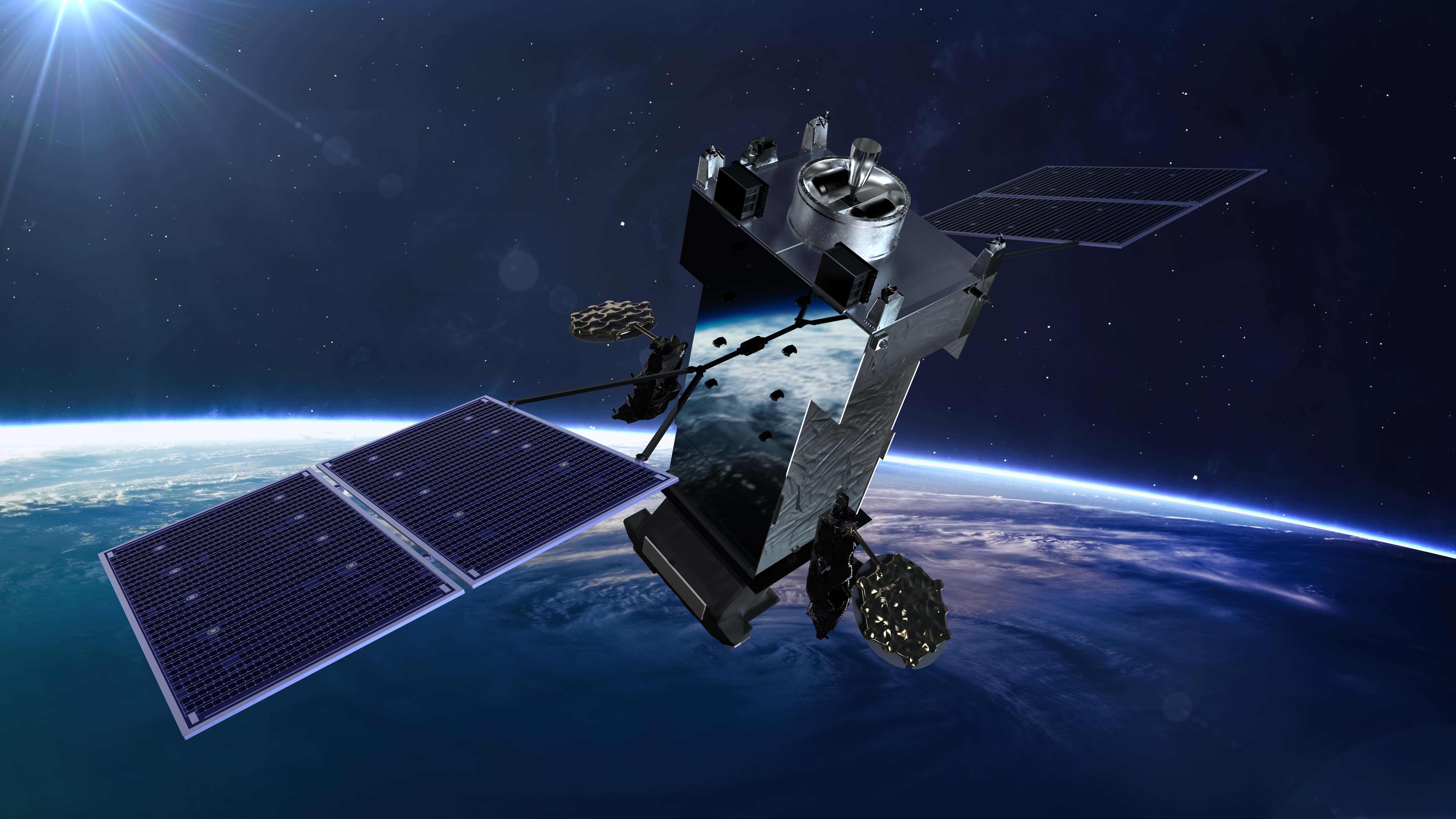
THE HAGUE, Netherlands — Polish researchers have collected detailed information on Russia’s Baltic Sea GPS jamming operations, a mysterious nuisance for aviators and mariners in the region that began when Russia attacked Ukraine.
The airwaves over the Baltic Sea have been compromised ever since the war began. In the past years, thousands of planes and ships have had their navigation systems bamboozled, with some ending up veering off course or even needing to cancel their trips altogether. The culprit behind these mysterious aberrations: radio waves emanating from secretive facilities run by Russia’s military.
Global Navigation Satellite System interference, which comes in the forms of jamming, which means blocking the signal, and spoofing, which entails gaming location readouts, has become a daily occurrence in northeastern Europe. From the airport of Gdansk through the busy shipping lanes of the Baltic Sea and all the way to the airspace of Estonia and Finland, these interferences have been recorded almost daily since Russia’s full-scale invasion of Ukraine in February 2022. They have even resulted in flight cancellations, airport closures and commercial ships steering off track.
Authorities in the Baltic states have laid the blame squarely on Russia. In March, eight European countries, including the Baltic states, Finland, Poland, France, the Netherlands and Ukraine, lodged a complaint with the UN about the practice. Several UN agencies have also taken up the issue, including the International Maritime Organization, the civil aviation authority ICAO and the International Telecommunications Union.
For its part, Russia – itself a Baltic Sea country and with part of its territory heavily affected by the jamming – has maintained official radio silence on the topic.
Open-source data and information released by governments in the Baltic states give some clues as to where these malicious signals might originate from. Two hotspots continuously pop up: Kaliningrad, Russia’s exclave wedged between Poland and Lithuania, and the St. Petersburg area. Both regions known to have a heavy Russian military presence, including divisions specialized in electronic warfare and radio.

“People have gotten so used to having satellite navigation,” said Jaroslaw Cydejko, adjunct assistant professor at Gdynia Maritime University. “Mariners should be able to navigate without it, but it has become a fact of life.”
Cydejko’s work focuses on GNSS use in the maritime domain. Traditionally working “on the brighter side of GNSS,” in the past few years, much of his research has pivoted to examining the mysterious emissions interfering with the satellites’ signals in the Baltic.
Russia is employing both jamming and spoofing, although in 2025, the interference has shifted from blocking the signals primarily to falsifying them, Cydejko says, citing his research group’s observations. Spoofing is the more advanced technique, and is generally tougher to detect and defend against.
Signal and noise
“Interfering with GNSS signals is, unfortunately, very easy,” said Ralf Ziebold, who is the head of the German Aerospace Center’s nautical systems department, housed in the institute of communications and navigation. Jamming is achieved by overpowering the weak signals originating from the global positioning satellites 20,000 kilometers above Earth’s surface, with radio signals emitted closer to home. Spoofing takes it one step further, by replacing the real signals with fakes that make it look like the receiver is somewhere it isn’t – and so can trick autopilots or captains to veer off course.
GNSS includes the United States’ GPS, Europe’s Galileo, and Russia’s GLONASS constellations, among others. The concept of GNSS interference has been a core component of electronic warfare for decades.
Cydejko, the Polish GNSS expert, is part of an international team of researchers that have worked to track the GNSS interference and determine its origin. They have set up several monitoring stations around the Gdańsk Bay and kept a close eye on the transmissions. The network became operational this year, just in time for a new wave of GNSS attacks.
Gdansk is not constantly affected by Russian jamming and spoofing, Cydejko said. Rather, the activities present a sporadic – although “annoying” and sometimes persistent – nuisance. The behavior shows that Russia is not, as some have suggested, using ship- or satellite-based transmitters against the Polish harbor city. This is confirmed by using his project’s listening posts to triangulate the origins of the signals.
The triangulations, which were conducted in the spring of this year and have been made available to Defense News, pinpoint two coastal locations in Russia’s Kaliningrad exclave with a precision of about one kilometer. Both are in close proximity to known electronic warfare units and military antenna sites.

A spoofing attack in May and a jamming attack in April both originated from the vicinity of the Okunevo antenna site on the central Kaliningrad coast. Beyond the permanent antenna installations there, it is an area that is known to have hosted electronic warfare units in the past, including ones designed to interfere with GNSS.
The GT-01 Murmansk-BN system, a set of trucks with powerful, 32-meter tall antennas designed to jam communications systems in a radius of 5,000 to 8,000 kilometers, is visible here in satellite images taken in September and October 2018, underscoring the location’s military use and precedent of jamming operations. The site is also just a few driving minutes away from the headquarters of a significant Russian electronic warfare unit, which open sources identify as the 218th Independent Electronic Warfare regiment.
A jamming attack in March was triangulated to the harbor town of Baltiysk, which is also home to the Russian Baltic Fleet and its electronic-warfare complex, a military facility packed with antennas and mobile EW units, although the triangulation appeared to resolve to a point southwest of the city, closer to the harbor.
GPS jammers and spoofers can be very small, even those with a large range, and might be easily overlooked in satellite imagery. Ziebold, the German researcher, said his team had purchased jammers the size of a shoe box that had a range of many kilometers.
This also means that they can be mobile. The jammer that has been plaguing Estonia, for example, appears to have moved from southwest of Saint Petersburg to northwest of the city.
This emerges from data shared by open-source intelligence researcher @auonsson, who is part of a network of social media activists examining the jamming saga on a technical level. The person behind the social media handle spoke Defense News on the condition of remaining anonymous.
Auonsson used aircraft-transmitted data to create a heatmap of possible jammer locations around Russia’s imperial city. The flight information transmitted by planes and used for live airplane tracker maps also contains information about the quality of GPS data; when an aircraft’s GPS quality suddenly drops, this suggests that a jammer has come up over the plane’s horizon. By plotting the horizons of thousands of flights when they first encountered jamming, a heat map can be created, allowing for an approximate idea of where the offending transmitter might be located. The source code for this experiment is available on GitHub, and the data on which the investigation is based is publicly available.
“I don’t consider the exact source very relevant for the public discussion,” the person behind the @auonsson handle said. “The country is, though,” they added, referring to Russia.
Jamming to what end?
Estonia, Lithuania, Latvia, Sweden and Germany have all officially declared the GNSS interference over this busy stretch of Europe as a form of Russian hybrid warfare. They have described it as a deliberate, malicious act with the intent to cause disruption – “a hybrid action to disrupt our lives and to break all kinds of international agreements,” as the Estonian foreign minister Margus Tsakhna put it.
Not all agree with this interpretation. Jamming around military facilities is commonplace, especially for countries at war, Cydejko, of Gdynia Maritime University, pointed out. He thinks the interference over the Baltic Sea and in neighboring NATO states is largely collateral, not the point of the operation.
Gdansk is far enough away from Kaliningrad that it should not be affected by GNSS interference from the exclave, as it lies behind the horizon. Indeed, it is intermittently affected, which has puzzled researchers. Cydejko’s working hypothesis is that this may be the result of atmospheric conditions.
“Probably this jammer is working constantly, but we are getting a signal at one time or another simply because of the weather,” he said. He was watching the spoofing on his equipment one warm day, he said, when a weather front moved through, bringing wind, rain and a temperature drop. As it got cold, the spoofing abruptly ended. Similarly, Gdansk had a reprieve from the signals over the winter, but they picked back up in springtime and are commonplace currently.
Because the malicious signals travel in direct line of sight, flights are affected at a greater distance from the transmitter than a ship at sea level. This is why GPS jamming maps, which are based on aircraft data, show a much larger area as being affected than might be the case on the ground.
Indeed, ships likely are not the target of the interference, according to researchers. “It’s electronic warfare with the aim of preventing being hit by things that use satellite navigation – drones,” said Ziebold of the German Aerospace Center DLR.
Back to the roots
Mariners and pilots should be able to navigate without GPS, according to Cydejko. Indeed, there are backup systems ranging from old-fashioned naval maps and binoculars to inertial positioning systems on aircraft. More advanced GPS receivers can also be resistant against a certain degree of jamming and spoofing, for instance by using antenna arrays or factoring in the direction of the signal.
There are some particularly vulnerable spots, such as Tartu’s airport, which has used exclusively GPS-dependent landing systems. The Estonian city’s airport faced flight cancellations and several re-routings as a consequence of GPS jamming; Finnair suspended flights there from April through May 2024.
Meanwhile, Ziebold’s team is deploying a modern incarnation of an old technology in the form of R-Mode Baltic. Instead of relying on satellite signals, it functions with existing land-based beacons. Ships equipped with Ranging Mode receivers can then calculate their position by measuring distances to multiple land-based stations, rather than relying on weak or erroneous satellite signals. The project, which receives EU funding, is being worked on by Germany, Poland, Sweden, Norway, Finland and Estonia, with Denmark as an associate partner.
Ziebold said the program is expanding to the aastern Baltic region, “where they have worse symptoms,” with stations currently being set up in Finland and Estonia. Germany’s DLR is taking the lead in the project, aiming to provide a pre-operational service to the countries’ national maritime authorities by 2026.
Several other countries are working on similar projects. The U.K. has become the first to deploy a land-based technology operationally in the form of the eLoran (Enhanced Long Range Navigation) system, which operates in low frequencies of 90 to 100 kHz and has been running since 2014. South Korea, frequently plagued by North Korean jamming attacks, is also actively developing an eLoran equivalent, while Russia, China, Saudi Arabia, India and the U.S. are all at varying stages of development for their own terrestrial navigation systems.

Battlefield Tech
C4ISRNet
Bitcoin
Ethereum
Monero

Donate Bitcoin to The Bitstream
Scan the QR code or copy the address below into your wallet to send some Bitcoin to The Bitstream

Donate Ethereum to The Bitstream
Scan the QR code or copy the address below into your wallet to send some Ethereum to The Bitstream

Donate Monero to The Bitstream
Scan the QR code or copy the address below into your wallet to send some Monero to The Bitstream
Donate Via Wallets
Select a wallet to accept donation in ETH BNB BUSD etc..











